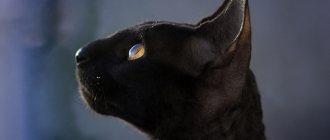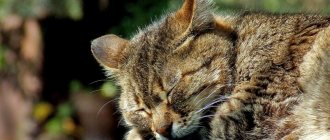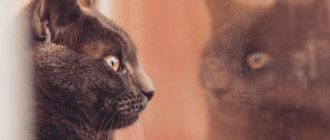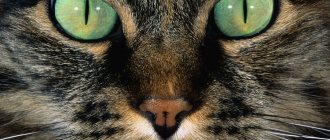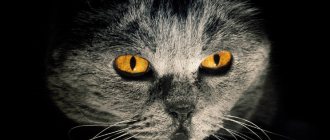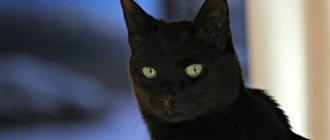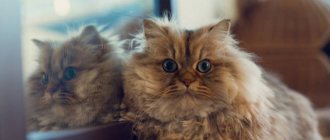07/13/2018 Category: Pets Author: Ekaterina Rogova
The hypnotic gaze of cat's eyes has long bewitched people. In Ancient Egypt, these animals were deified and mummified after death, and in the Middle Ages they were considered minions of the devil, associates of witches and burned at the stake. In the 21st century, prejudices are still alive: some people bring cats with different-colored eyes into their home to attract good luck, others avoid the gaze of their pets at dusk, for fear of causing trouble. And even scientists are still scratching their heads, trying to understand what secrets the cat’s gaze hides.
- 2 Can cats see in the dark
2.1 Video: cartoon about why cats’ eyes glow in the dark
- 5.1 Video: a film for cats starring birds
- 6.1 Video: kittens meet their mirror double
- 7.1 Video: Do cats see parallel worlds?
How many colors can cats distinguish?
It was previously thought that cat reality was black and white, but this is not entirely true. It’s just that the world of Murka is painted in pastel colors and devoid of bright accents. In addition to white, black and twenty-five shades of gray, purrs distinguish between green, blue and yellow, but they do not perceive red and all its variations. Lighting is also important: on a sunny day, yellow appears white to fluffies, and green and blue turn into dark gray at dusk.
Cats may mistake orange for green, and red for dark gray.
This is due to the structural features of the cat's eye. Its retina contains two types of cells - rods and cones. The former are sensitive to light and are responsible for twilight vision, while the latter are involved in color recognition. Nature equipped the cat's eye mainly with rods, allowing it to hunt at night, considering that there was no special need for cones.
If a person has four rods per cone, then cats have as many as twenty-five
I always admire nature, and I still perceive rainbows as a miracle. Previously, I tried to share my delight with my favorite, naively pointing my finger at the sky and persuading her to admire this beauty. But Manya never understood me. Only now it became clear to me that cats simply do not notice the rainbow, because many colors appear to them as different shades of gray. In addition, fluffies do not perceive contrasts well, so faded blue and green stripes against a blue or gray sky run the risk of being overlooked.
Why are they active at night?
The reason your pets are more active at night is because of the lifestyle of their ancestors. In ancient times, wild cats hunted at dusk. At this time, the heat had subsided and it was still light enough to see, pursue and catch prey.
The twilight hours gave cats the advantage of not being noticed by predators, who were more active in daylight and in the darkness of night.
And during the day there was enough time to rest and recuperate.
Can cats see in the dark?
Cats' eyes are unique night vision devices. At dusk, unsurpassed hunters are able to distinguish more than a hundred shades of gray, notice the smallest details of the situation and all the body movements of a potential victim. However, for this, predators still need a light source, for example, the reflection of the moon, a star or a candle flame. In pitch darkness, cats, like people, do not see anything, orienting themselves in space with the help of additional tools - ears, nose and whiskers.
The deficiency of cones in the retina of a cat's eye, responsible for the perception of color, is more than compensated by the abundance of rods, providing highly detailed night images
The ability of purrs to see in semi-darkness is due to the unique structure of their eyes:
- Depending on the lighting, a cat's pupil can expand and contract in a split second. During the day, it resembles a narrow slit about 0.5 mm wide, protects the retina from exposure to sunlight and helps judge distances. In the dark, the pupil enlarges to one centimeter in diameter and absorbs light;
American scientist Martin Banks noticed that the shape of the pupil of representatives of the cat family depends on the method of hunting. Thus, miniature predators that attack their prey from ambush have vertical pupils. Large wild cats - lions, tigers, cheetahs - use their sprinting skills when catching prey, which is why their pupils are always round.
Depending on the time of day and lighting, a cat's pupil can take on the shape of a bead, a rugby ball, or a keyhole. - Behind the retina there is an additional membrane covering the fundus of the eye - the tapetum. Its mirror surface is capable of reflecting light absorbed by the pupil and returning it to the retina. As a result, twilight vision becomes sharper, and the eyes of the murk begin to emit a mystical glow.
Blue-eyed cats scare their owners at night with a red demonic light, and those with amber eyes bewitch them with green.
A special reflective layer - tapetum - helps a cat navigate in twilight fifteen times better than a human
My cat sees perfectly in the dark, performs “feats” every night, and diligently patrols the territory. In the light of day, the beast seems to be replaced: the angel is peacefully basking in the sun, squinting her eyes, or openly sleeping without her hind legs. In rare moments of playfulness, when Manka is hunting for a string that either moves or freezes, her pupils dilate sharply, her gaze becomes playful, she stupidly shakes her head, tries to merge with the floor, simultaneously shuffling her hind legs. This way she demonstrates an extreme degree of interest in the object and meticulously calculates the trajectory of the future jump.
Video: cartoon about why cats' eyes glow in the dark
https://youtube.com/watch?v=5uKqxqsNOgc
Important point
Even knowing why cats see in the dark, some owners conduct incredible experiments on their pets. They place them in a room without windows, such as a pantry, or install a toilet in a dark corner. In such situations, the cones and pupils are not able to help the animal, since even the slightest light source is absent.
An animal in such an environment usually experiences anxiety. This is not due to the fact that the pet sees the other world (as some people believe), but to natural instincts. If the tray is placed in a dark corner, the animal is more likely to find a safer place for itself - on the carpet in the middle of the room, in the shoes of the owners, who are in the illuminated corridor, etc. Whether the pet should be blamed for the offense in this case is a controversial issue.
How cats see in the dark: video
How Far Can Cats See?
Cats are naturally nearsighted. Their visual acuity is only 0.2–0.1, while in a healthy person this value reaches 1.0. The world, more than twenty meters away from the fluffies, is a cloudy and blurry spot. They won’t even be able to see their beloved owner, but they will recognize them by their smell. Cats observe the clearest picture in the range from seventy centimeters to seven meters. This distance is optimal in order to determine the distance and force of the jump to the desired prey during the hunt.
Murkas will also not notice objects located directly under their nose. Their eyes lack the muscles that allow them to adjust the shape of the lens and focus on nearby objects. In such cases, our pets use auxiliary means - smell and touch.
Cats are sensitive to movements, so prey running in a horizontal plane can be noticed at a distance of up to a kilometer, while a potential victim frozen nearby risks being lost sight of. This is explained by the fact that the retina of a cat's eye is richly equipped with rods responsible for recognizing moving objects and the acuity of night vision.
Cats are not able to appreciate all the beauty of the landscape, but objects flickering at some distance will certainly attract their attention. I have been
convinced more than once that cats cannot see well up close. When Manya comes up to me and begs for a forbidden tasty treat with a pleading look in her eyes, I am unable to refuse. I throw her a piece of cheese or sausage, and for a long time she pokes her muzzle into the floor and calls on her sense of smell to help, looking for the long-awaited delicacy. If she notices the treat from afar, then she goes straight to it.
Sleep duration
Cats sleep a lot during the day, up to 15-20 hours.
But if you look closely, you will notice that in fact they do not sleep for 20 hours straight. This is where the term “cat nap” comes from. It consists of short periods - from 15 to 30 minutes throughout the day.
Separated work from life: why Justin Bieber put his phone aside
How Fukushima's underground ice wall prevents radiation from escaping into the Pacific Ocean
A little butter and the taste is completely different. Bright vegetable side dish
Moreover, they do not sleep soundly all this time. They mostly doze, remaining somewhat vigilant in case danger approaches.
How cats perceive space
Like humans, purrs have binocular (stereoscopic) vision. The two pictures that each eye sees are superimposed on each other, allowing the animal to perceive the world as three-dimensional, accurately determine the shape of objects and the distance to them, which gives a head start on the hunt.
Cat vision allows you to perceive three-dimensional reality
Cats' eyeballs are convex and large, but are located deep in the skull, which limits their movement. Therefore, the animal is forced to turn its head in order to take a closer look at what is happening from the side. But nature compensated for this deficiency by giving cats the “breadth of sight” that peripheral vision provides. The viewing angle available to murks is about 200⁰, while a person sees the world only at 180⁰.
Oriental cats (Siamese, Orientals, Abyssinians), whose eyes are widely spaced, can see space at 270⁰.
Cats see a panoramic picture, although it is rather blurry and faded in the periphery.
Sometimes I approach my cat from the back and, looking into her face from the side, I begin to make frightening grimaces. Manya does not turn her head, but I clearly understand that she is watching me, moving her eyes restlessly and trying to squint them as much as possible. When I make a sharp gesture, she turns around because she can't handle the suspense any longer. Such experiments confirm that cats have a wide viewing angle and are able to notice something looming behind them, but what exactly requires clarification.
Vision problems: how to notice them
Cats suffer from various vision disorders quite often. The owner should be wary if the animal hides its eyes from bright light or often rubs its face with its paws. Signs of inflammation are frequent blinking of the pet, pus in the corners of the eyes, clouding of the whites, swelling of the eyelids. Any of these signs is a reason to immediately consult a veterinarian.
Kittens that are blind at an early age have much longer whiskers than their kittens. This is how nature compensates for the lack of visual perception of the world
Some eye diseases can cause complete blindness in your pet. It is difficult to notice vision problems in cats in order to take timely measures, since they are able to navigate in space even with complete blindness. The following signs indicate that vision problems have begun and should be checked:
- the animal does not jump to its favorite places located at a height or, when jumping, misses and falls;
- when moving around the house, he comes across moved or new furniture, objects standing in unusual places;
- your pet’s pupils do not constrict in bright light;
- stops responding to favorite toys;
- when the pet looks at the owner, his gaze does not focus on him.
All these signs indicate a deterioration in the cat’s vision or the onset of blindness.
What to do if your cat begins to see poorly
Unfortunately, it is not always possible to restore a pet’s vision, but this is not a reason to abandon a sick animal. The owner should organize the space of the home in such a way that the animal feels comfortable. Your pet can live a full life if you do the following:
- do not change the location of bowls with food and water;
- do not let the animal out into the street unattended, take it for a walk on a leash;
- in a new room, accustom the cat to the location of objects, without frightening them and allowing them to find their own way;
- do not block the path with boxes, scattered toys and other objects.
How many frames per second can a cat recognize?
Many owners claim that their cats love to watch TV, preferring channels about animals. Small predators freeze at the sight of their wild counterparts, closely follow the flight of birds, and sometimes try to pick them up with their paws. Whether our pets are really watching what is happening on the monitor at this moment or are they attracted by sounds and flickering is an open question.
Video: a film for cats starring birds
The global standard for filming is 24 frames per second, while the mustachioed stripes perceive up to fifty. Therefore, many scientists believe that cats see a set of slides on the screen, i.e., dynamic scenes seem intermittent to them. However, nature films that show 60 frames per second (60 fps) are already available on the Internet. They are the ones who are able to please our pets with a clear, smooth and realistic image.
Cats won't be interested in news - they prefer the action genre
Furry animals and their owners will get the greatest pleasure from watching videos on LCD monitors with 4K resolution and a refresh rate of 120 Hz. In the meantime, such devices have not appeared in every home, some advanced cats are excited to catch virtual mice on the screen of tablets.
I never noticed that my Manya was interested in TV, but for fun I decided to show her a cat video. For some time she watched the fussy movements of birds and rodents and even waved the tip of her tail. I was glad and waited for her to start squeaking pitifully and chattering her teeth, as she always does when she sees living birds. Alas, this did not happen. Literally a minute later, Manya turned away and yawned eloquently.
Video: ginger cat plays with a virtual mouse
Why do animals watch TV?
Cats definitely can't see images on a screen the same way we can. Zoologists believe that they only see flickering and moving pictures. This is why owners often note that their pets watch programs about animals, but at some point they lose interest.
And when a cat looks in the mirror, it experiences cognitive dissonance, a complete discrepancy between the incoming information and the formed ideas. The animal sees its fellow, but does not feel its presence by smell and temperature. Attacking your reflection in the mirror is an attempt to deal with this discrepancy.
What does a cat see in the mirror?
Of course, cats see their own reflection in the mirror, but they do not recognize themselves. The first reaction will depend on temperament: some will want to play with the uninvited guest, others will boldly go into battle, and others will cowardly retreat. But interest and wariness quickly pass, since the animal’s sense of smell and hearing do not provide any additional information about the mysterious stranger.
Kittens usually show curiosity when they see a mirror, but very soon the interest in this piece of furniture evaporates
In ancient times, superstitious people explained the negative reaction of a cat to a mirror by the fact that it sees otherworldly entities in it. In fact, the animal is trying to protect its possessions from the encroachments of the “alien”, who stares straight ahead and arches his back threateningly, therefore posing a challenge.
Only a few representatives of the animal world have the ability to recognize themselves in a mirror image: great apes (orangutans, gorillas, chimpanzees), dolphins, elephants, magpies, stingrays. Children begin to identify themselves at the age of one and a half years.
My cat has never shown any abnormal activity when looking at a mirror. At the first meeting, she only thoroughly sniffed the surface from all sides and immediately forgot about the existence of this object. The creature that Manya saw in the reflection did not impress her at all. Live cats are a completely different matter. From the very first moments, with a guttural growl, she delicately asks them to stay away from her.
Video: kittens meet their mirror double
https://youtube.com/watch?v=xQ9KA2LYJJU
Glow in other members of the cat family
Not only domestic cats, but also wild ones can boast of glowing eyes: manulas, pumas, lynxes, cheetahs, tigers and everyone else. A similar effect is observed in other tapetum owners:
Read also: Baby won't roll over
- spiders;
- crustaceans;
- fish;
- mice and rats;
- rabbits;
- dogs;
- horses;
Do cats see the other world?
Since ancient times, people have believed in the supernatural abilities of cats. It is not for nothing that when moving to a new house, the honorable role of pioneers fell to the lot of the murks. They had to strike up a friendship with the brownie, so that later, in tandem with him, they would protect the home and owners from dangers. In large cities today there are even special companies that rent cats for housewarming for two thousand rubles.
The presence of a cat in the house promises well-being and protects against evil spirits.
Our pets can accurately identify sources of negative energy. For example, those areas of the apartment that attract cats are considered geopathogenic, so it is not recommended to place a bed there. In addition, animals are able to diagnose ailments of internal organs and do their best to heal their beloved owners by lying on sore spots.
Some impressionable cat breeders believe that animals see the souls of the dead or evil spirits when they stare unblinkingly into the void, as if watching someone, or start a sudden game with an invisible man. Skeptics explain this behavior by the presence of well-developed sense organs in cats. If they are able to perceive ultrasound, inaccessible to the human ear, in the nature of which there is nothing supernatural, then they can easily become interested in the rustling sounds coming from the neighboring apartment. Acute twilight vision will help the cat to see in the twilight some flying insect that is invisible to people, and unexpected jumps, somersaults and running will express the purring desire to frolic with a new companion.
A rational explanation for the unusual behavior of a pet does not at all exclude the existence of a parallel reality, because modern quantum physics has long gone beyond traditional ideas about the structure of the universe
Over the 13 years of marriage, I have studied my favorite well. In 99% of cases, all oddities in her behavior can be explained logically. Although one precedent struck fear. One late evening, by the light of a night lamp, my family and I watched a mystical thriller. Everyone was on edge from what was happening on the screen when the dozing Manya suddenly jumped up, bent, fluffed up and stared at the ceiling. From the rush of horror, I broke into falsetto, which further heated the situation. Manya did not take her eyes off the ceiling for a long time and looked around cautiously. The reason for this reaction remained a mystery, but fortunately it was the first and last time. The location of geopathogenic zones in our apartment is also classified, because a lazy and heat-loving cat is only interested in batteries.
Video: Do cats see parallel worlds?
How to stop people waking you up at night
Although cats are not technically nocturnal, they often keep their owners awake. Do you like to wake up in the middle of the night from the stomping of a cat's feet or loud meowing? I think it's unlikely. Your pet's nighttime games will drive anyone crazy, especially if you have to work tomorrow.
And my friends’ cat imagines himself as a night sniper: having climbed up the carpet to the ceiling, he sharply dives down, as if on the head of a sleeping person. And then it soars up to the loud cries of its owner. But as soon as he lies down and turns off the light, the cat goes into a steep dive again. Locking him in another room is not an option; they live in a one-room apartment. But during the day, this wonderful creature is very cute, does not make a sound, curls up in a chair, sleeps until the evening. As the owner says, it is recharging and saving strength for the night.
But there are several effective ways to calm your pet. I hope the information is useful to you.
- Include active games and dinner an hour before bedtime in his evening schedule. As a result, he himself will want to rest. And you will sleep.
- Stir your cat throughout the day, buy interactive toys with which he can jump and play to his heart's content. Why store energy at night?
- Ignore the cat if it wakes you up. Otherwise, he will learn this method for getting food or sharing nightly entertainment. Hide and don't make a sound, otherwise you'll have to play by his rules.
- Don't let your pet into your bedroom. Designate a separate area for him in another room, leaving free access to food, water and toilet.
- But don't be angry with the cat if he wakes you up. He doesn't do this to annoy you. These are just natural instincts.
Found a violation? Report content
A little about the paranormal
There are many guesses and assumptions that cats can see spirits and ghosts. Of course, these versions do not yet have a scientific basis, but rumors about the superpowers of pets have been exciting the minds of mankind for several centuries. And any cat owner has probably noticed oddities in the behavior of their pet.
A brief excursion into the history of the issue
For several millennia, the cat has been considered the most mysterious and mystical animal known to mankind. Representatives of ancient civilizations worshiped cats, considering them sacred. These animals were attributed to divine origin. Many pagan religions represented them as intermediaries, guides between the world of the living and the kingdom of spirits and ghosts.
In medieval Europe, during the witch hunts, cats had a hard time. Their praise in paganism was perceived by Christianity as closeness to Satan. This is where the modern superstition about black cats comes from. In those troubled times, they were considered one of the guises of witches, sorcerers and werewolves. As a result of many years of persecution, furry purrs were almost completely destroyed in Europe.
Some scientists believe that epidemics of plague and cholera are natural consequences of the extermination of purrs. After all, mice and rats began to multiply and freely spread pathogens of dangerous diseases.
What really is
There is no denying the fact that pussies sometimes follow the movements of something invisible with their eyes. Many owners can tell stories about inappropriate behavior of their pets when they watch something in an empty space for a long time. The animal may jump up sharply, hiss, its fur stands on end, and its pupils dilate. Some pussies even throw a kind of hysteria with wild screams and running around. They rush around the room, not making out the way, knocking down and breaking everything in their path.
The scientific explanation for such phenomena may be as follows. A cat's vision is not very clear, especially regarding stationary objects. Changes in the environment are primarily perceived by the ears. Therefore, having noticed an unexpected movement or movement where there was just a monochromatic blurry picture, the animal simply gets scared and behaves inappropriately (especially if this happens during the daytime). This version has a right to exist.
But if you think about it, you can justify this from the other side. The achievements of modern science prove that there is a world beyond human perception. There is ultrasound, which we cannot hear, but animals hear perfectly well. There are light waves that our eyes cannot perceive. So is it possible to say that the world of spirits and ghosts is fiction? Perhaps it is the cat that has the ability to perceive the environment much wider and deeper than a person can do. By the way, psychics and mediums claim that furry pets can even communicate with the world of the dead.
